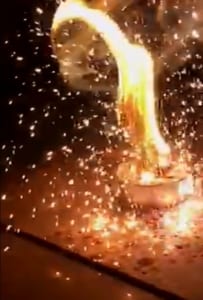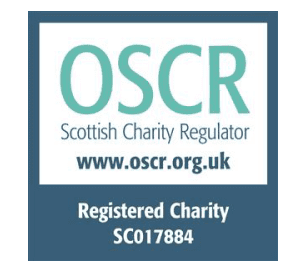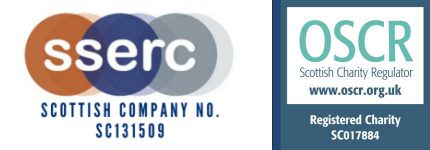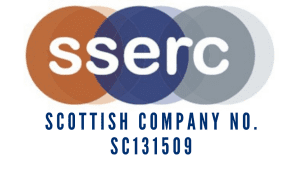
Image by C Lloyd at SSERC (Public Domain)
According to the CfE Experiences and Outcomes document:
Learners gradually develop an understanding of chemical changes. They consider processes which take place in the environment and in the laboratory, and develop their understanding of the environmental impact of some changes. They develop their understanding of energy changes in chemical reactions and some of the factors affecting the rates of reactions. Learners develop the use of chemical names, formulae and equations as a way of conveying information about chemical changes.
The three tabs below let you look at Level 3 SSERC chemistry activities to help teaching the three parts of this area.
SCN 3-18a
Having taken part in practical activities to compare the properties of acids and bases, I have demonstrated ways of measuring and adjusting pH and can describe the significance of pH in everyday life.
Colourful Flowers (demo) – Make paper ‘flowers’ soaked in different buffer solutions. Then spray indicator on and you get different colour flowers.
Indicators – microscale – a small scale investigation into indicators and pH.
Law of Similar Shapes (Demo) – Simple neutralisation reactions with phenolphthalein.
Rainbow Reaction (Demo) – Form a rainbow of colours to illustrate pH scale with hydrochloric acid and sodium carbonate along the length of a burette.
Spell Casting (Demo) – Clear liquid poured into beakers fails to change colour until the last one – phenolphthalein indicator – due to tiny amounts of acids/bases in beakers.
Vinegar Cheats (workshop) – Using a simple titration (with pipettes) to find out which samples of vinager have been watered down.
SCN 3-19a
Through experimentation, I can identify indicators of chemical reactions having occurred. I can describe ways of controlling the rate of reactions and can relate my findings to the world around me.
Bleaching Blue Food Dye (workshop) – simplified version of a more advanced experiment looking at how blue food dye is decoloured bu household bleach.
Blue Bottle Reaction (demo) – Redox Reaction – on standing methylene blue solution turns clear, shaking turns it back to blue.
Blue Light (Demo) – Luminol reaction. A chemical experiment that produces light but not heat.
Cannon Fire (Demo) – Potassium permanganate catalyses breakdown of hydrogen peroxide mixed with Ethanol. Burning ethanol/hydrogen peroxide mixture is quiet but loud bangs appear on addition of permanganate.
Catalyst at Work (Demo) – Rochelle Salt and hydrogen peroxide, catalysed by cobalt chloride, shows different colour intermediate.
Colourless, Orange or Blue (Demo) – The oscillating Briggs-Rauscher reaction (as used in antioxidants).
A Cool Experiment (demo) – A very endothermic mixture of barium hydroxide and ammonium thiocyanate freezes a beaker to a wet plank/mat
Electric Writing (Demo) – Electrical reduction to produce alkaline hydroxide ions which are shown up by indicator where you have ‘written’.
Electrolysis of lead bromide – microscale – a small scale version of the classic experiment that does not need to be carried out in a fume cupboard.
Elephant’s Toothpaste (Demo) – Foam produced by catalytic decomposition of hydrogen peroxide with detergent and food colouring.
Equilibrium and Le Chatelier (demo) – effect of temperature on equilibrium – a complex is coloured differently in hot and cold.
Fizz pops (workshop) – Using vitamin C tablets and bicarbonate of soda in 35mm film canisters to follow a reaction rate.
Fire Writing (demo) – Draw trail on filter paper with sodium nitrate and dry it. Then light end of trail and watch the fire smoulder along the path.
Flame Colours (Demo) – Using atomiser bottles for flame tests.
Gloopy and Gooey (Demo) – Gaviscon in copper sulphate solution and PVA/Borax cross-linking polymers.
Growing Silver Trees (Demo) – a displacement reaction with copper wite and silver nitrate that produces dentritic crystals of metallic silver.
Hot Stuff (Demo) – Exothermic spontaneous reaction of glycerol with potassium permanganate.
Invisible Writing (Demo) – Invisible ink made from Aspirin is revealed by an Iron sulphate spray.
Lemons (workshop) – Investigating the effect of concentration and temperature on rate of reaction using lemon juice and potassium permanganate.
Light Sticks (Demo) – Effect of temperature on luminosity of glow-sticks.
Methane bags (Demo) – Burning bags with different ratios of methane:oxygen in.
Methane Bubbles (Demo) – Preparing and igniting bubbles of methane.
Methane Tin (Demo) – Using an old coffee tin with a methane flame from hole in top. Air comes in and eventually you get the right ratio for an explosion to blow the lid off.
Polymer Slime (workshop) – Making slime from borax and PVA glue – and looking at the properties as the composition varies.
Rhubarb Rhubarb (workshop) – (Similar to Lemons) Using rhubarb decolourising potassium permanganate to follow the rate of reaction, looking at concentration and surface area. Plus a fun demo version – stir a beaker of dilute potassium manganate VII with a stick of rhubarb, the solution goes clear.
Screaming Jelly Baby (Demo) – Molten potassium chlorate V causes rapid combustion of sugar in a jelly baby.
Silver Mirror (Demo) – Ammoniacal silver nitrate is prepared and this is reduced in a flask by a reducing sugar leading to a coating of silver on its inside.
Thionin (Demo) – A photochemical reduction. Thionin is a different colour in light and dark.
Traffic Lights (Demo) – A reversible redox reaction variant on the blue bottle reaction. Dye changes colour on shaking and reverts on standing.
Turning Copper Coins into Silver and Gold (Demo) – Zinc plating a copper coin with sodium zincate and then heating it to make brass.
Vitamin C Drops (workshop) – Determining the concentration of Vitamin C in a variety of fruit juices using a simple titration with iodine.
Whoosh Bottle (Demo) – Ignition of alcohol vapour in a 15l water bottle to produce a spectacular ‘whoosh’.
SCN 3-19b
I have helped to design and carry out practical activities to develop my understanding of chemical reactions involving the Earth’s materials. I can explain how we apply knowledge of these reactions in practical ways.
Copper Etching (workshop) – Activity using the displacement reaction between copper sulphate solution and zinc plate to etch a design.
Fizz pops (workshop) – Using vitamin C tablets and bicarbonate of soda in 35mm film canisters to follow a reaction rate.
Lemons (workshop) – Investigating the effect of concentration and temperature on rate of reaction using lemon juice and potassium permanganate.
Vinegar Cheats (workshop) – Using a simple titration (with pipettes) to find out which samples of vinager have been watered down.



